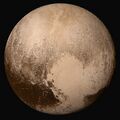Astronomy:K2-3
From HandWiki
Short description: Red dwarf star in the constellation Leo
| Observation data Equinox J2000.0]] (ICRS) | |
|---|---|
| Constellation | Leo[1] |
| Right ascension | 11h 29m 20.39171s[2] |
| Declination | −01° 27′ 17.2817″[2] |
| Apparent magnitude (V) | 12.168±0.009[3] |
| Characteristics | |
| Spectral type | M0V[4] |
| B−V color index | 1.35 ± 0.06[4] |
| Astrometry | |
| Radial velocity (Rv) | 30.24±0.46[2] km/s |
| Proper motion (μ) | RA: 94.116[2] mas/yr Dec.: −78.003[2] mas/yr |
| Parallax (π) | 22.7374 ± 0.0220[2] mas |
| Distance | 143.4 ± 0.1 ly (43.98 ± 0.04 pc) |
| Details[5] | |
| Mass | 0.549+0.029 −0.027 M☉ |
| Radius | 0.546+0.018 −0.016 R☉ |
| Luminosity (bolometric) | 0.0587+0.0018 −0.0019 L☉ |
| Surface gravity (log g) | 4.704+0.023 −0.026 cgs |
| Temperature | 3844+61 −63 K |
| Metallicity [Fe/H] | −0.157+0.075 −0.080 dex |
| Rotation | 40±2 d[6] |
| Age | 6.9±4.7 Gyr |
| Other designations | |
| Database references | |
| SIMBAD | data |
K2-3, also known as EPIC 201367065,[4] is a red dwarf star with three known planets. It is on the borderline of being a late orange dwarf/K-type star, but because of its temperature, it is classified as a red dwarf (4,000 K is typically the division line between spectral class M and K).
At a distance of 143 light-years (44 parsecs),[2] the star's proximity means it is bright enough to make it feasible for astronomers to study the planets' atmospheres to determine whether they are like Earth's atmosphere and possibly conducive to life.
Planetary system
K2-3 has three confirmed exoplanets, discovered in 2015.[7] All are low-density super-Earths or sub-Neptunes, with the outermost orbiting near the inner edge of the habitable zone.[8][5]
| Companion (in order from star) |
Mass | Semimajor axis (AU) |
Orbital period (days) |
Eccentricity | Inclination | Radius |
|---|---|---|---|---|---|---|
| b | 5.11+0.65 −0.64 M⊕ |
0.0778±0.0026 | 10.054626(0) | <0.094 | 89.588+0.12 −0.100° |
2.078+0.076 −0.067 R⊕ |
| c | 2.68±0.85 M⊕ | 0.1414±0.0047 | 24.646582(39) | <0.095 | 89.905+0.066 −0.088° |
1.582+0.057 −0.051 R⊕ |
| d | <1.6 M⊕ | 0.2097±0.0070 | 44.556456(97) | <0.097 | 89.788+0.033 −0.029° |
1.458+0.056 −0.051 R⊕ |
References
- ↑ Roman, Nancy G. (1987). "Identification of a Constellation From a Position". Publications of the Astronomical Society of the Pacific 99 (617): 695–699. doi:10.1086/132034. Bibcode: 1987PASP...99..695R. Vizier query form
- ↑ 2.0 2.1 2.2 2.3 2.4 2.5 Vallenari, A. et al. (2022). "Gaia Data Release 3. Summary of the content and survey properties". Astronomy & Astrophysics. doi:10.1051/0004-6361/202243940 Gaia DR3 record for this source at VizieR.
- ↑ Henden, A. A. et al. (2016). "VizieR Online Data Catalog: AAVSO Photometric All Sky Survey (APASS) DR9 (Henden+, 2016)". VizieR On-line Data Catalog: II/336. Originally Published in: 2015AAS...22533616H 2336. Bibcode: 2016yCat.2336....0H.Vizier catalog entry
- ↑ 4.0 4.1 4.2 "K2-3 PLANET HOST OVERVIEW PAGE". NASA Exoplanet Archive. http://exoplanetarchive.ipac.caltech.edu/cgi-bin/DisplayOverview/nph-DisplayOverview?objname=K2-3&type=PLANET_HOST.
- ↑ 5.0 5.1 5.2 Diamond-Lowe, Hannah et al. (2022), "The K2-3 System Revisited: Testing Photoevaporation and Core-powered Mass Loss with Three Small Planets Spanning the Radius Valley", The Astronomical Journal 164 (5): 172, doi:10.3847/1538-3881/ac7807, Bibcode: 2022AJ....164..172D
- ↑ Kosiarek, Molly R. et al. (2019). "Bright Opportunities for Atmospheric Characterization of Small Planets: Masses and Radii of K2-3 b, c, and d and GJ3470 b from Radial Velocity Measurements and Spitzer Transits". The Astronomical Journal 157 (3): 97. doi:10.3847/1538-3881/aaf79c. Bibcode: 2019AJ....157...97K.
- ↑ Crossfield, Ian J. M. et al. (2015). "A Nearby M Star with Three Transiting Super-Earths Discovered by K2". The Astrophysical Journal 804 (1): 10. doi:10.1088/0004-637X/804/1/10. Bibcode: 2015ApJ...804...10C.
- ↑ Damasso, Mario et al. (2018). "Eyes on K2-3: A system of three likely sub-Neptunes characterized with HARPS-N and HARPS". Astronomy and Astrophysics 615: A69. doi:10.1051/0004-6361/201732459. Bibcode: 2018A&A...615A..69D.
- ↑ Bonomo, A. S. et al. (April 2023). "Cold Jupiters and improved masses in 38 Kepler and K2 small-planet systems from 3661 high-precision HARPS-N radial velocities. No excess of cold Jupiters in small-planet systems". Astronomy & Astrophysics. doi:10.1051/0004-6361/202346211.
 |




